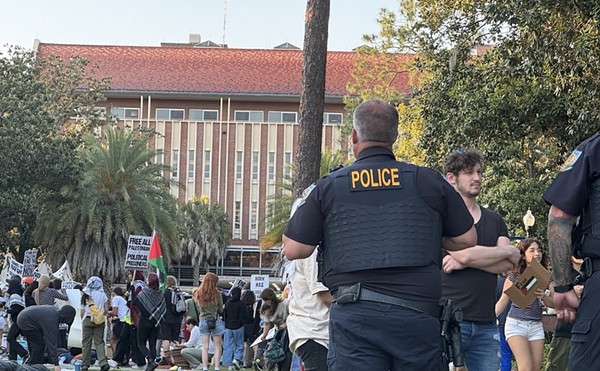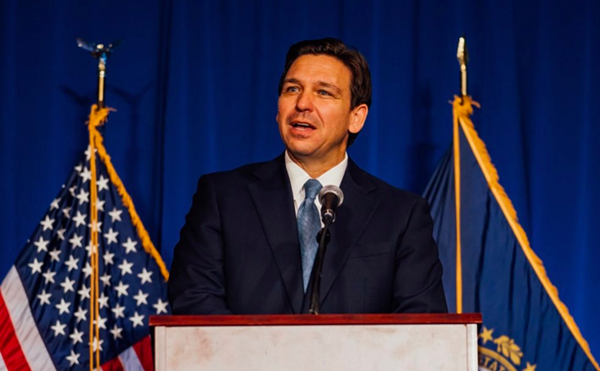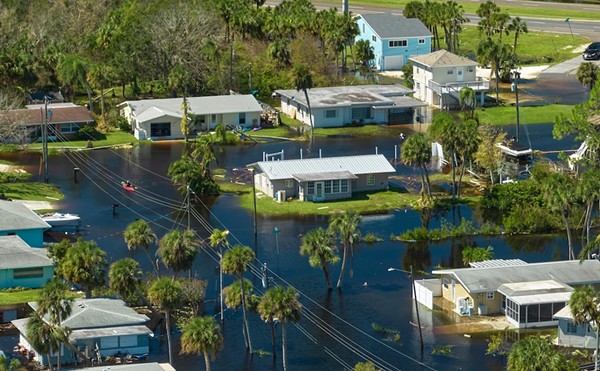Feral cats are not yet taking over the world; it only seems that way. Informed estimates put the number at something like 60 million of the little beasts roaming the United States. To put that in perspective, that's equivalent to the population of Florida and California combined, plus another 10 million or so.
The feral cat population here in Florida is estimated at about 6 million. While the numbers aren't solid, two things are for sure: Feral cats are a fast-growing nuisance, and they are also the focus of a battle between people who love them and people who would rather see them gone.
Here in Florida, the argument is between the Fish and Wildlife Conserva-tion Commission and cat-protection groups statewide. The FWCC, a state-run organization charged with protecting Florida's environment, sees ferals as a danger to native wildlife, mainly beach mice and birds. So they've come up with a policy to do away with them.
Naturally, that policy has pro-cat people upset. They would like the state to come up with a more humane solution. This is where the drama begins to unfold.
On May 30, at a town-hall meeting in Kissimmee, the FWCC unveiled their "Policy on Feral and Free Roaming Cats" to a packed house of more than 150 people. The policy itself is backed by a rolling, 30-page "issue assessment" that details the damage feral cats can wreak on the state's native wildlife. It asserts that the best way to deal with ferals on state land, where wildlife can be affected, is by killing them.
Pro-kitty groups advocate for something called "trap, neuter and return," or TNR. The idea, as the name implies, is to capture cats, sterilize them, then put them back where you found them.
In a legal sense, the battle between the FWCC and pro-TNR groups may already be over. Alley Cat Allies -- a Washington, D.C.-based, pro-TNR organization -- tried to stop the FWCC from adopting a kill-the-cats policy. But on Aug. 29, a state administrative law judge in Orange County rejected the argument that the FWCC was acting illegally. Alley Cat Allies has 30 days to appeal. Donna Wilcox, the group's executive director, says her group has not yet planned its next move.
But the pro-TNR movement is big and getting bigger. So it's hard to believe they are ready to give up the fight.
For the kitties
It wasn't until 1990, with the formation of Alley Cat Allies, that the "feral cat movement" and the promotion of TNR in general became much more than just compassion for stray cats. Nonprofit, pro-feral groups multiplied like the wild cats themselves. Suddenly, cat lovers were not alone.
In Florida, there are at least 10 such groups, from Feline Rescue Adoption Program in Jacksonville to The Cat Network in Miami. Tampa has the Animal Coalition of Tampa; Lake Park has Adopt A Cat Foundation. In Gainesville, Operation Catnip provides Alachua County with free TNR programs. All the organizations operate with the help of private donations and funding.
Cost is a factor in this game. The average figure for low-cost spay-and-neuter procedures is $30 to $50 per animal. When compared to an estimated cost of a $100 for the state to euthanize a cat -- a price that includes sending a wildlife officer to catch the animal, house the animal, feed it, then destroy it and dispose of the body -- the pro-TNR groups have economics on their side.
"We have a unique program," says Connie Graham, director of CARE: Feline Rescue, the spay/neuter program here in Orange County. "We are open to all residents of Orange County. It's $15 for males, $22 for females, and free for anyone on public assistance. The majority of the cost is absorbed by the county."
Any cost "absorbed" by the county is ultimately absorbed by taxpayers. This very thing, however, is what makes CARE unique. The spay/neuter clinic is provided as a service to the community; like trash removal or road work. Since its creation in late 1995, CARE has performed spay/neuter procedures on more than 10,000 cats, bringing the total cost into the neighborhood of $400,000 to $500,000. The figure would easily double if the same number of cats had been killed, based on the state's price for doing the deed. So the price of destroying one animal in Orange County can sterilize three, possibly four.
Over in Brevard, things are a bit different for the Space Coast Feline Network. In 2002, the county donated $26,000, which was used for spay/neuter procedures, and to purchase land and build a housing facility for ferals taken out of the wild. The rest of the Feline Network's money comes from private donations and from the pockets of members themselves.
Kathleen Harer, president of the Feline Network, feels the FWCC is overstating the danger feral cats pose. "They (FWCC) don't have a scientific basis for the policy," says Harer. "They are using outdated data, and we encouraged them not to make their policy until they did a long-term study on the effects of trap, neuter and return. Besides, the biggest cause of a decline in [wild] animals is humans."
Dr. Julie Levy, professor of veterinary medicine at the University of Florida and one of the foremost experts on feral cats, thinks that Feline Network's viewpoint might be a bit extreme. "I don't think there are any bad guys in this story," says Levy. "I do think everybody is trying to make Florida a better place. I think our job is to figure out how to bring all the stakeholders together and find solutions to meet everybody's goals."
The goal, ultimately, is to reduce the number of cats. Pro-TNR groups feel the sole intention of the FWCC is to remove the cats by any means necessary to solve a problem that may or may not exist. They are concerned that enforcement of the policy will one day spill over from state land, and feral cats everywhere will be targeted as a result. Which has turned into something akin to paranoia for cat lovers, with some going as far as to refer to the FWCC as "cat hunters," "rifle-wielding rednecks" and "Nazis."
The accusations have given way to a more substantial theory: Feral cats are fast becoming a diversion for the true enemy of the environment -- urban sprawl.
"I don't think the FWCC is under the illusion that problems with development do not exist. And in a lot of ways they're powerless against development and sprawl, so they're targeting something they can tackle," continues Levy. "But they are quoting a lot of data from unpublished sources. In fact, a lot of the policy's language is lifted straight from American Bird Conservancy literature, which is an organization that's not pro-feral. It's definitely not unbiased, which is supposed to be the purpose of the policy."
For the birds
Exploding populations of stray cats and raccoons fed by humans reportedly have decimated a world famous heron and egret rookery of several thousand birds in Greynolds Park in Dade County, Florida. Songbird populations have also plummeted. People can no longer enjoy this park because of the defecation and spraying of cats.
This is an excerpt from an essay titled "Managed Cat Colonies: The Wrong Solution to a Tragic Problem." You can find this essay nestled inside the web-based literature of a campaign operated by the American Bird Conservancy called "Cats Indoors." The basic design of the campaign is to bring awareness to the fact that birds apparently are meeting gruesome deaths in the mouths and claws of free-roaming cats.
The American Bird Conservancy is a nonprofit bodyguard for wild birds and their habitats throughout the country. And it's painfully obvious that wild birds need bodyguards if there's any truth to the scene described above. It seems the citizens of Miami, or at least the people who enjoyed using the park, couldn't come to grips with a violent squadron of cats and raccoons who waged war on the birds and shit on everything in sight. All they could do was feed the beasts, and that did nothing but make them stronger.
But a concern with the language of the FWCC's policy is that it was taken, at times verbatim, from ABC's Cats Indoors literature. It's not readily apparent that phrases or statements were transferred from one document to the creation of another. But there's no mistaking that the FWCC's policy and literature for the Cats Indoors campaign say the same thing: Feral cats are bad for the environment.
The FWCC has reportedly softened its policy from earlier drafts because it underestimated public response. Later versions call for killing cats only on state land. What was once a general condemnation of feral-cat colonies on both public and private land has shifted its focus.
The FWCC distributes literature for the ABC, but state officials say that is as far as the connection goes. "I'm not aware of anything being lifted from ABC's literature, but then again I'm not aware of ABC's literature," says Brad Gruver, deputy chief of the Division of Wildlife for the FWCC.
Nonetheless, there is a vague fear among pro-cat groups that the FWCC's new policy represents the first step down the slippery slope of slaughtering ferals. The FWCC, on the other hand, claims the policy is nothing more than a tool for setting direction inside the agency. "The policy is internal guidance to us," says Gruver. "What you have to do, is determine where they're making an impact on wildlife and come up with a solution for that area. You really can't confront the statewide problem. The statewide problem is addressed through educating people."
There is no large-scale proven method for successfully reducing the numbers of feral cats. The only way is to remove the cats altogether or completely keep them from breeding. Then you still have to stop the incoming flow of new cats, and let the existing population thin themselves out naturally through attrition. Unfortun-ately, this is unrealistic, unless you live on an island.
Yet, the largest colony of feral cats giving the FWCC a strained and desperate glare these days is a managed bunch in Key Largo. The colony is inside a community adjacent to a habitat for endangered rodents known as Key Largo woodrats and Key Largo cotton mice. The situation in Key Largo is what the FWCC is citing as a specific example of feral cats endangering wildlife. "These cats have easy access to the woodrat, but we don't have a picture of a cat with a woodrat in its mouth, if that's what you mean," says Gruver. "But the Key Largo woodrat population has dropped over the years from hundreds of animals to dozens of animals."
Old data
The FWCC admits their policy was written with data from Internet searches and feral-cat studies done everywhere from Florida to Wisconsin to Australia, some dating back more than 20 years. This lack of recent research is enough to suggest to pro-TNR groups that the FWCC was writing the policy heavily in their own favor.
But the FWCC's deepest wound was harshly self-inflicted on May 23, a mere seven days before they planned to unveil their brand-new policy in Kissimmee. During a phone call made by Dennis David -- a regional director of the FWCC -- to Alley Cat Allies, David left a running, joking commentary with a unidentified man on Alley Cat Allies' voice mail after he thought the recording had expired. The brief conversation finds David and the other individual chatting rather candidly about feral cats, the policy (which at the time was still to be voted on) and their plan to reduce the feral-cat population: "So, I should wear my uniform when I'm shooting these neighborhood cats, right?" asks one of the voices on the tape.
The tone of the message isn't necessarily one of malice; David and the unidentified party seem to be mocking Alley Cat Allies, if not pro-TNR groups in general, more than anything else. But it's not a good sign if the people who are writing policy don't take the opposing side seriously.
David couldn't be reached for comment. Gruver says the message is "unfortunate," but he doesn't think it affects policy.
The truth is the policy will be ineffective to counties that already have successful management programs in place. The FWCC's policy only applies to state land or land managed by the FWCC, and never mentions the killing of feral cats as a primary or even essential option. There will be no teams of officers roaming the streets.
"The primary emphasis of the policy is to protect native wildlife from the impact of feral and free-ranging cats," continues Gruver. "The policy is not go out there and kill people's cats, or snatch cats from people's yards, or any of these things I've typically heard."
Where things stand now, there seems to be little hope for an understanding between the two sides. It's unfortunate, considering both parties want the same result. The FWCC's indictment against feral cats is slim on evidence. And with the exception of the message left on Alley Cat Allies' voice mail, the pro-TNR people have not proven the policy is aimed at destroying the feral-cat population.
"This is a 10-year-old movement, so we're still trying to figure out what works," says Levy "It's not well-funded, not well-organized and basically all private. It's a young field, and that's why there is a debate."
One thing's for sure; the cats will keep screwing like fiends, and the humans will keep arguing about what to do.
"We're attacking a huge and chronic ... problem," continues Dr. Levy. "Illiter-acy, AIDS, poverty, racism -- all those things are huge social problems that private groups and government can chip away at but don't expect overnight success. I think we should look at this in the same way and be realistic. So, I expect this to go on for decades."


















